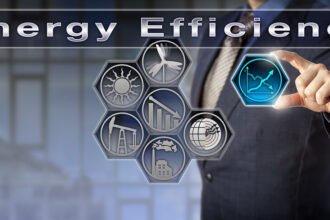In the second part of our Investing in Data Center Efficiencies series, we will focus on two of the three levels of investments data centers can incorporate to become more energy efficient. (Read part one.)
In the second part of our Investing in Data Center Efficiencies series, we will focus on two of the three levels of investments data centers can incorporate to become more energy efficient. (Read part one.)
Infrastructure Changes
The second level of investment is changing a data center’s infrastructure. Data centers can monitor, maintain, and replace equipment and virtualize their infrastructure to a private cloud. This level requires more of a financial investment, but could pay for itself with energy cost savings.
Hot/Cold Aisle Containment
Hot/cold aisle containment refers to a physical barrier limiting the mixing of cold air and hot exhaust air. At Online Tech, all of our Michigan data centers are designed using hot/cold aisle containment. At the end of the row of cabinets, a hidden plastic container directs all of the cold air into the center of the servers. This maximizes the use of the cold air to cool the equipment by lessening the amount of cold air escaping. This type of barrier could result in a 20% energy savings calculates Pacific Gas and Electric Company.
Monitor & Maintain Equipment
By monitoring and maintaining your existing equipment, you can reduce energy consumption. You should develop an ongoing maintenance program to evaluate if your data center’s equipment is working properly or if you need to upgrade to more efficient equipment. Monitoring equipment can measure the temperature and humidity of data centers and automatically make adjustments.
Upgrade to More Efficient Equipment
Today more energy efficient equipment is available. Although it might be costly to replace initially, over time energy savings will outweigh the capital costs.
Incorporate More Efficient Air Conditioners By replacing your old air conditioners with more efficient air conditioners, you can take advantage of the 20 to 40 percent efficiency improvement.
Upgrade to Digitally Controlled UPS
This type of upgrade is much more gut wrenching and more expensive, but it can offer you a lot of savings, says Online Tech Co-CEO, Yan Ness. In 2011, Online Tech invested over $1 million dollars into their Mid-Michigan data center to incorporate higher energy efficiencies and to achieve a fully redundant and audited IT infrastructure.
Air conditioning units were upgraded to new units that are much more energy efficient. Also, the entire UPS infrastructure was replaced resulting in an additional 100KW and increasing energy efficiencies from 80% to 92.5%.
These improvements resulted in Online Tech becoming Michigan’s first data center to achieve the U.S. Environmental Protection ENERGY STAR Certification, putting Online Tech in the top 25 percent of facilities in the nation regarding energy performance.
Move Infrastructure to Private Cloud
Ness says that the biggest step Online Tech took toward becoming more energy efficient was to virtualize the company’s infrastructure into a private cloud. Online Tech had 30 to 40 internal servers and moved them into a private cloud. This easily lowered the amount of energy used to power 30+ servers, cool the servers as well as the space that housed them.
Strategic Planning
The third level of investment requires a company to plan more long-term and strategically.
Select Cooler Geographical Regions
One of InformationWeekly’s top data center trends for 2013 is considering different geographical climates to help lower energy costs. Many data centers are now being built in cooler regions, like Michigan, to take advantage of the favorable, year round temperatures. Michigan’s annual average temperature is 60 degrees for the high and 40 degrees for the low. These ideal temperatures allows Michigan data centers to use less energy for cooling compared to data centers in warmer climates.
Outsource Your Data Center
We know there are many businesses across the country that house their servers in closets and back rooms. What they do not realize is how much money they are truly spending for cooling and power costs. Many times colocation makes much more economical sense. By using colocation, companies can quickly lower energy costs to power servers as well as keeping them cool. Another benefit is that companies can use the space that was currently housing server equipment into more productive, revenue-generating office space.
Another scenario is when companies have multiple locations housing a server at each. The company is paying for power and cooling for each location. In addition, companies may want to update to more energy efficient equipment; however it would be very expensive to update equipment at all locations.
This is when colocation may make more “green” sense – both financially and environmental. A company could centralize all of their servers into one data center. This would lower energy expenses over multiple locations. For simplicity sake, let’s say that it costs $1,000/mth for energy costs per location. A company has 10 locations, so that is $10,000/mth or $120,000 per year in energy costs.






